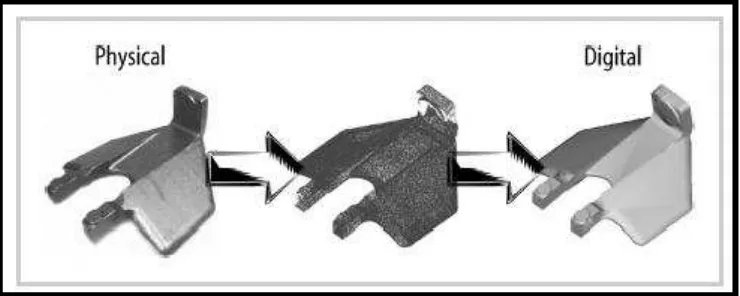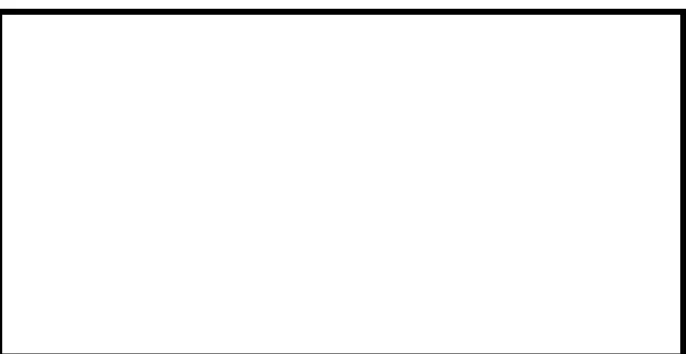UNIVERSITI TEKNIKAL MALAYSIA MELAKA
REVERSE ENGINEERING ON 3D SCANNED DATA FOR
CAD/CAM PROGRAMMING USING DELCAM AND CATIA V5
SOFTWARE
This report is submitted in accordance with the requirement of the Universiti Teknikal Malaysia Melaka (UTeM) for the Bachelor of Manufacturing Engineering
Technology (Process and Technology) with Honours
by
MOHAMED AIMAN BIN RAFEEK AHMAD B071210584
910316-03-5967
UNIVERSITI TEKNIKAL MALAYSIA MELAKA
BORANG PENGESAHAN STATUS LAPORAN PROJEK SARJANA MUDA
TAJUK: Reverse Engineering On 3D Scanned Data For CAD/CAM Programming Using Delcam And Catia V5 Software
SESI PENGAJIAN: 2015/16 Semester 1
Saya MOHAMED AIMAN BIN RAFEEK AHMAD
mengaku membenarkan Laporan PSM ini disimpan di Perpustakaan Universiti Teknikal Malaysia Melaka (UTeM) dengan syarat-syarat kegunaan seperti berikut:
1. Laporan PSM adalah hak milik Universiti Teknikal Malaysia Melaka dan penulis. 2. Perpustakaan Universiti Teknikal Malaysia Melaka dibenarkan membuat salinan
untuk tujuan pengajian sahaja dengan izin penulis.
3. Perpustakaan dibenarkan membuat salinan laporan PSM ini sebagai bahan pertukaran antara institusi pengajian tinggi. atau kepentingan Malaysia sebagaimana yang termaktub dalam AKTA RAHSIA RASMI 1972)
(Mengandungi maklumat TERHAD yang telah ditentukan oleh organisasi/badan di mana penyelidikan dijalankan)
Alamat Tetap:
iii
DECLARATION
I hereby, declared this report entitled “Reverse Engineering On 3D Scanned Data for CAD/CAM Programming Using Delcam and Catia V5 Software” is the results of my
own research except as cited in references.
Signature :………
Name : Mohamed Aiman Bin Rafeek Ahmad
iv
APPROVAL
This report is submitted to the Faculty of Engineering Technology of UTeM as a partial fulfillment of the requirements for the degree of Bachelor of Engineering Technology (Technology of Manufacturing Engineering Process and Technology) (Hons.). The member of the supervisory is as follow:
………. Mr. Muhammad Syafik Bin Jumali
(Project Supervisor)
………. Mr. Syahrul Azwan Bin Sundi @ Suandi
v
ABSTRACT
vi
ABSTRAK
vii
DEDICATIONS
Special dedication to my beloved parents,
Mr. Rafeek Ahmad bin Mohamed Sidek and Mrs. Rosni binti Sidik
Also for my kind hearted supervisor and co-supervisor,
Mr. Muhammad Syafik Bin Jumali and Mr. Syahrul Azwan Bin Sundi @ Suandi
viii
ACKNOWLEDGMENTS
First and foremost, Alhamdulillah, I would like to praise Allah S.W.T for giving me the strength to endure the Project Sarjana Muda with a great success. It is known that, this PSM is one of the most important subjects that must be endured by all UTeM students as requirement to get a degree.
I would like to Special thanks both of my supervisor Mr. Muhammad Syafik Bin Jumali and co- supervisor Mr. Syahrul Azwan Bin Sundi @ Suandi for their commitment, support, advice, time share and guidance given. They help contribute lots in order to complete this project successfully. Not forgotten, for all lecturer, technicians and person involves with their invaluable support, cooperation, shared of information and also their experiences especially Mrs. Intan Zarina binti Mohd Yusoff, Mohd Syafiq, Mr. Nor Fauzi and Mr. Zuhri.
I would also like to express greatest thankful to my beloved parents, Mr, Rafeek Ahmad Bin Mohamed Sidek and Mrs. Rosni Binti Sidik for giving me their support and motivation during my good and hard times in order to ensure completion of this project. Not forgotten, special thanks to all my friend for their help, support and information given. Thank to all who directly or indirectly have been help contribute and full support though the project period
ix 2.1.2 Forward Engineering and Reverse Engineering Process 6 2.1.3 Application of Reverse Engineering 7
2.1.4 Need for Reverse Engineering 9 2.1.5 Working Processes of Reverse Engineering 10
2.1.6 The Principles and Implementation of Reverse Engineering 11
2.2 3D Scanner 12
x
2.2.3 Geomagic Studio Software 15
2.2.4 IGES Format 15
2.2.5 Advantage IGES Format 16
2.3 CAD/CAM Programming 16
2.3.1 Introduction CAD/CAM Programming 16
2.3.2 Computer Aided Design (CAD) 16
2.3.3 Computer Aided Manufacturing (CAM) 17
2.4 Catia V5 Software 18
2.4.1 Introduction Catia V5 Software 18 2.4.2 Application Catia V5 Software 18
2.4.3 Advantages Catia V5 Software 19
2.5 Delcam Software 19
2.5.1 Introduction Delcam Software 19
2.5.2 Application Delcam Software 20
2.5.3 Advantages Delcam Software 21
2.6 CNC Machine 22
2.6.1 What is CNC Machine 22
2.6.2 3-Axis CNC Machine 23
2.7 Surface Roughess 23
2.7.1 Description of surface roughness 23 2.7.2 Surface Roughness and It’s Important 25
xi
4. RESULT & DISCUSSION 39
4.1 Result 39
4.1.1 Programming Process(setup method) 40 4.1.2 View For Machining Sample And CAD Part 42 4.1.3 Surface Roughness Test For Sample
Using Catia V5software 44
4.1.4 Surface Roughness Test For Sample
Using Delcam Software 47
4.2 Discussion 50
4.2.1 Result Analysis And Comparison 50
4.2.2 Result for 3D Scanning 55
4.2.3 Comparison between Catia V5 and Delcam Software 57 4.2.4 Comparison Surface for Machining Product 62
5. CONCLUSION & RECOMMENDATION 65
5.1 Conclusion 65
5.2 Recommendation 67
REFERENCE 69
xii
LIST OF FIGURES
Figure 2.1 Physical to digital process 6
Figure 2.2 Forward Engineering Process 6
Figure 2.3 Reverse Engineering Process 7
Figure 2.4 Prosthetic finger duplicated by reverse engineering 9
Figure 2.5 Working Processes of RE 11
Figure 2.6 3D Scanner 12
Figure 2.7 Preview Part in VX Element 13
Figure 2.8 Surface Triangle 14
Figure 2.9 Surface roughness tester 24
Figure 3.1 Flow Chart 27
Figure 3.7 CAD/CAM Programming 33
Figure 3.8 Machining Process 34
Figure 3.9 Select raw material and squaring process 34
Figure 3.10 3-Axis CNC Milling Machine 35
Figure 3.11 During Machining process 35
Figure 3.12 Analyze data 36
Figure 3.13 Surface roughness tester 37
xiii
Figure 3.15 Surface roughness tester process 38
Figure 4.1 Machining Product for Catia V5 42
Figure 4.2 CAD Part Model for Catia V5 42
Figure 4.3 Machining Product for Delcam 43
Figure 4.4 CAD Part Model for Delcam 43
Figure 4.5 Point Area for Surface Roughness Test (Catia V5 Sample) 44 Figure 4.6 Graph Average Surface Roughness for Catia V5 Sample 46 Figure 4.7 Point Area for Surface Roughness Test (Delcam sample) 47 Figure 4.8 Graph Average Suraface Roughness for Delcam Sample) 49
Figure 4.9 Graph Data for Point 1 50
Figure 4.16 Comparison Graph Data Between Catia and Delcam Sample 54
Figure 4.17 Scanning Process 55
Figure 4.18 Scanning result in Geomagic Software 56
Figure 4.19 Result of 3D Scanner 56
Figure 4.20 Creating Stock in Catia V5 and Delcam Software 57 Figure 4.21 Process and Operation Selection for Machining Process 58
Figure 4.22 Properties for Process Details 59
xiv
xv
LIST OF TABLE
Table 4.1 Process one 41
Table 4.2 Process two 41
1
CHAPTER 1
INTRODUCTION
1.1 Background of Study
2
and better shape. Geomagic Studio is and easy-to-use software system designed to help you take advantage of generating CAD models directly from free-form scan data. You will see the most benefit with Geomagic Studio if projects involve generating CAD data of free form shapes, non-parametric models and quick conversation of scan to CAD (www.3dscanco.com, accessed on 20 Mei 2015).
3
system utilizes an internal computer. The internal computer allows for the following: storage of additional programs, program editing, running of program from memory, machine and control diagnostics, special routines, and inch/metric-incremental/absolute switch ability. CNC Machine have three, four and five-axis, but in this project only focus on three-axis only. accomplished in two-axis combinations by y feeding the table or cross-slide in the XY, XZ or YZ planes in a predetermined path and distance from the machine spindle or headstock. The CAD model will be machine using 3-Axis CNC Milling Machine and will be analyze on surface roughness and dimensional accuracy (Thomas M. Crandell, 2003).
Coordinate Measuring Machine (CMM) is use to verify the dimensional accuracy of machining part. Coordinate measuring Machine (CMM) are extremely powerful metrological instruments, enable to locate point coordinates on three-dimensional structures at the same time that they integrate both dimensions and the orthogonal relationships. Surface roughness tester is to verify a condition surface roughness of machining part after done by using CNC Milling Machine. The evaluation of surface roughness of machined parts using a direct contact method has limited flexibility in handling the different geometrical parts to be measured. Surface roughness also affects several functional attributes of parts, such as friction, wear and tear, light reflection, heat transmission, ability of distributing and holding a lubricant, coating etc.
1.2 Problem Statement
4
technology of their newest car like shape, system, material and other. So the engineer hard to have a drawing, tough to get the part that their need in a CAD model and need a part from other automotive companies to modify. So they need a technology that can copy in actual part quickly, can preview the part in a CAD model, can modify a part in CAD model, and it is the rapid process.
In reverse engineering applications it is not desirable to copy these deviations. The goal of reverse engineering in these applications is to capture the engineering principles used in the design of the part, for modification of the part and not to make an exact copy of the physical part. To successfully use reverse engineering in these applications, specialized software and engineering analysis is required in this project.
1.3 Project Objective
The object of the project is:
1. To make a comparison between both CAD/CAM programming namely DELCAM and CATIA V5.
2. To investigate the machining result for both software process focusing on surface roughness.
1.4 Project Scope
The scope of project will be focused on:
1. This project will be focusing on two types of CAD / CAM programming which are CATIA V5 and DELCAM Software.
2. The part which is used in the research is an actual part that has been scanned using a 3D scanner.
5
CHAPTER 2
LITERATURE REVIEW
2.1 Reverse Engineering
2.1.1 What is Reverse Engineering
6
model is the source of information for the CAD model. This is also referred to as the physical-to-digital process depicted in Figure 2.1. Another reason for reverse engineering is to compress product development cycle times. In the intensely competitive global market, manufacturers are constantly seeking new ways to shorten lead times to market a new product. For example, automotive company need to design a part for a new car in short time. By using reverse engineering, a three-dimensional physical product or clay mock-up can be quickly captured in the digital form, remodeled, and exported for rapid manufacturing using multi-axis CNC machining techniques (Vinesh Raja, 2008).
Figure 2.1 : Physical to digital process Source: Vinesh Raja, 2008
2.1.2 Forward Engineering and Reverse Engineering Process
7
Figure 2.3:Reverse engineering process Source: Zhiliang Xia, 2014
2.1.3 Application of Reverse Engineering
Reverse engineering can be used in various kinds of fields range from automotive to architecture and medical to software applications. Below are some examples of applications of reverse engineering in different kinds of fields.
(a) In Aerospace and Ship Hull Craft
8
To overcome obstacles in data exchange.
To short out problems arising from discrepancies between the CAD master model and the actual tooling or as-built part.
To confirm the quality and performance by computer-aided inspection and engineering analysis.
(b)In Mechanical Industry
9
Reverse engineering has been employed in generating data to create dental or surgical prosthetics (artificial body parts which replace missing part), tissue engineered body parts, or for surgical planning. A virtually perfectly custom-fit prosthetic can be duplicated to replace the missing part such as knee joint, femur bones and teeth lost by injury (traumatic) or missing from birth (congenital) or to supplement defective body parts. Figure 2.4 shows how reverse engineering is applied in medical field to produce a prosthetic finger (Toh Ban Sheng, 2009).
Figure 2.4:Prosthetic finger duplicated by reverse engineering Source: Toh Ban Sheng, 2009
2.1.4 Need for Reverse Engineering

